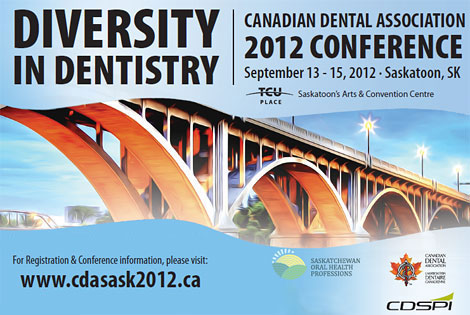Use of Lasers in the Non-Surgical Treatment of Patients with Periodontal Diseases

In this edition of JCDA Express, Dr. Debora Matthews, professor and chair of the department of dental clinical sciences at Dalhousie University, examines the clinical evidence related to the use of lasers and photodynamic therapy in treating patients with periodontal disease. Three papers review the clinical effectiveness of alternative or adjunct treatments in comparison to conventional therapy of scaling and root planning (SRP).
|



|
Introduction
Therapeutic lasers have been used for over 50 years. Since the late 1990s, they have been promoted as a safe and painless way to treat periodontal diseases.
In principle, the use of lasers seems to be a good idea. Conventional periodontal therapy, such as SRP, for routine chronic periodontitis has several known limitations. These include difficulty accessing furcations, grooves, concavities and deep pockets; the time and physical effort required for hand instrumentation; possible patient discomfort; and contaminated aerosol formation from ultrasonic instruments. In comparison, lasers offer a number of potential advantages: bleeding control, selective calculus ablation and bactericidal effects against periodontal pathogens.
Despite these potential benefits, there is a dearth of clinical evidence demonstrating a benefit to the adjunctive use of lasers compared to conventional periodontal therapy for the treatment of chronic periodontitis. At least a dozen systematic reviews over the last 10 years have shown that lasers provide no advantage over traditional non-surgical periodontal therapy. However, the clinical trials themselves are—for the most part—poor quality.
The question remains: Why do clinicians provide expensive laser therapy—that offers patients no demonstrated advantage—over traditional therapies? Equally important, as noted in a recent review1 that compared the effectiveness of lasers versus scaling for chronic periodontitis, “one cannot help but ask why manufacturers expect clinicians to pay a premium for lasers, when manufacturers are unwilling to invest in high quality clinical trials.”
|

|
Nd:YAG Lasers
Slot DE, Kranendonk AA, Paraskevas S, Van der Weijden F. The effect of a pulsed Nd:YAG laser in non-surgical periodontal therapy. J Periodontol. 2009;80(7):1041-56.
Full-text access to this article has expired.
JCDA Clinical Pearl: Currently, there is no evidence to support use of a Nd:YAG laser for the purpose of subgingival SRP, either as a monotherapy or adjunctive to standard mechanical debridement.
Key Points:
-
Theoretically, the Nd:YAG laser (with or without water cooling) has a potential application in periodontal therapy because the wavelength is not readily absorbed by hard tissues such as cementum or dentin.
-
Eight studies met the inclusion criteria for this systematic review: randomized controlled clinical trials evaluating Nd:YAG alone or in addition to SRP, in comparison to a control group using conventional therapy or a placebo laser.
-
The 8 included studies were of poor quality. Seven studies were at high risk of bias (the other was at moderate risk) because it was unclear if any of the studies conducted a sample size calculation, none adequately blinded the randomization of participants, and only one study used blinding of treatments appropriately. Five studies contained incomplete or insufficient data on 2 or more of the outcomes being measured.
-
Meta-analysis was not possible due to major differences in study design and lack of data. A descriptive analysis reported that one study favoured Nd:YAG laser therapy over SRP, while the others did not. Similarly, only one study reported a difference in clinical attachment levels favouring the laser.
Reasons for recommending this article:
Results of more recent articles2,3 support the findings of this systematic review. Although the authors of these studies report slight advantages of the Nd:YAG laser, the results are not clinically meaningful, and do not hold true for the long term.
|

|
Er:YAG Lasers
Sgolastra F, Petrucci A, Gatto R, Monaco A. Efficacy of Er:YAG laser in the treatment of chronic periodontitis: systematic review and meta-analysis. Lasers Med Sci. 2012;27(3):661-73. Epub 2011 May 7.
Full-text access to this article has expired.
JCDA Clinical Pearl: Erbium lasers show the greatest potential for effective root debridement. However, there is no evidence that erbium lasers improve any clinical outcomes over and above those achieved with SRP.
Key Points:
-
The Er:YAG laser has been shown, in vitro, to remove calculus and to negate the effects of endotoxins.
-
Five small studies (105 patients in total) were included in the systematic review and meta-analysis. Two studies were at low risk of bias. The other 3 studies were at high risk of bias due to the lack of a sample size calculation, inadequate randomization and inadequate description of patients lost to follow up.
-
Meta-analysis found there was no difference between laser therapy and SRP for pocket depth reduction, clinical attachment level gain, or increased recession at either 6 or 12 months.
Reasons for recommending this article:
This is a high-quality review with more stringent methodology than earlier reviews. The results of this study support the findings of other meta-analyses published in 3 other reviews4,5,6.
|

|
Antimicrobial Photodynamic Therapy
Sgolastra F, Petrucci A, Gatto R, Marzo G, Monaco A. Photodynamic therapy in the treatment of chronic periodontitis: a systematic review and meta-analysis. Lasers Med Sci. 2011;Oct 16. (Epub ahead of print)
Full-text access to this article has expired.
JCDA Clinical Pearl: Current best evidence shows that photodynamic therapy (PDT) alone provides no advantages over SRP alone. In combination with SRP, in the short term, there are limited advantages to PDT but the results are clinically meaningless. Further, any advantage does not seem to extend beyond 3 months.
Key Points:
-
Subgingival SRP is the most common method to treat periodontitis; however, mechanical therapy does not completely eliminate periodontal pathogens, as bacteria can persist in radicular cementum and dentinal tubules, or migrate from reservoirs within the mouth to periodontal sites.
-
Several adjunctive therapies have been proposed to improve the clinical and microbiological outcomes of non-surgical periodontal therapy, including PDT. Laboratory- and animal-based research has shown PDT to be an effective antimicrobial treatment as activation of photosensitive dyes by light, in the presence of oxygen, leads to the formation of free radicals that are cytotoxic to microorganisms.
-
A systematic review with a meta-analysis compared patients who received PDT alone with patients who received PDT in addition to SRP, or SRP alone.
-
The results of the meta-analysis show that patients who received PDT in addition to SRP had, after 3 months, a very small advantage over those who received SRP, in terms of clinical attachment gain (0.07–0.40 mm) and pocket depth reduction (0.04–0.37 mm).
-
There were no differences between the 2 groups after 6 months.
-
Microbiological changes varied greatly from study to study, with 2 studies favoring PDT plus SRP in reducing bacterial species, and 2 showing no differences.
Reasons for recommending this article:
This article uses current best practices to conduct a thorough review of the available literature. The authors used a wide search strategy with no language restrictions and excluded the possibility of publication bias (i.e. including studies that only show positive results).
|

|
References
-
Niederman, R. Are lasers as effective as scaling for chronic periodontitis? Evid Based Dent. 2011;12(3):80-1. doi:10.1038/sj.ebd.6400811
-
Gómez C, Domínguez A, García-Kass AI, García-Nuñez JA. Adjunctive Nd:YAG laser application in chronic periodontitis: clinical, immunological, and microbiological aspects. Lasers Med Sci. 2011;26(4):453-63. Epub 2010 Jun 10.
-
Qadri T, Javed F, Poddani P, Tunér J, Gustafsson A. Long-term effects of a single application of a water-cooled pulsed Nd:YAG laser in supplement to scaling and root planing in patients with periodontal inflammation. Lasers Med Sci. 2011;26(6):763-6. Epub 2010 Jun 27.
-
Cobb CM. Lasers in periodontics: a review of the literature. J Periodontol. 2006;77(4):545–64.
-
Schwarz F, Aoki A, Becker J, Sculean A. Laser application in non-surgical periodontal therapy: a systematic review. J Clin Periodontol. 2008;35(8 Suppl):29-44.
-
Karlsson MR, Diogo Löfgren CI, Jansson HM. The effect of laser therapy as an adjunct to non-surgical periodontal treatment in subjects with chronic periodontitis: a systematic review. J Periodontol. 2008;79(11):2021-8.
|

|
Other articles of interest:
|

|
|

|
|
|
|
|
|
|

JCDA is the authoritative written voice of the Canadian Dental Association, providing dialogue between the national association and the dental community. It is dedicated to publishing worthy scientific and clinical articles and informing dentists of issues significant to the profession.

|
|

|
|

|
|

|
|

ITI Congress Canada
"New Technologies and Best Practices in Implant Dentistry"
September 21-22
Westin Harbour Castle, Toronto
ITI Education Week Toronto
"Best Practices in Implant Dentistry"
October 24-27
Holland Bloorview Kids Rehabilitation Hospital, Toronto
|
|
NOTES AND NEWS
JCDA would like to gratefully acknowledge the publishers of the selected articles, who have granted free access to the full-text papers until August 24, 2012.
Journal of Periodontology
(publisher: American Academy of Periodontology)
Lasers in Medical Science
(publisher: Springer)
|
|
Search the JCDA Classified Ads
Looking for employment? Want to sell your practice? Classified ads offer the most effective way to reach all dentists and students in Canada.
|
|
Spread the word
Help spread the word about JCDA Express by telling your colleagues about it and reminding them to send CDA their email address.
reception@cda-adc.ca
|
|

|
|

|
|

|
|

Dr. John P. O'Keefe
Director, Knowledge Networks
jokeefe@cda-adc.ca
|
|



